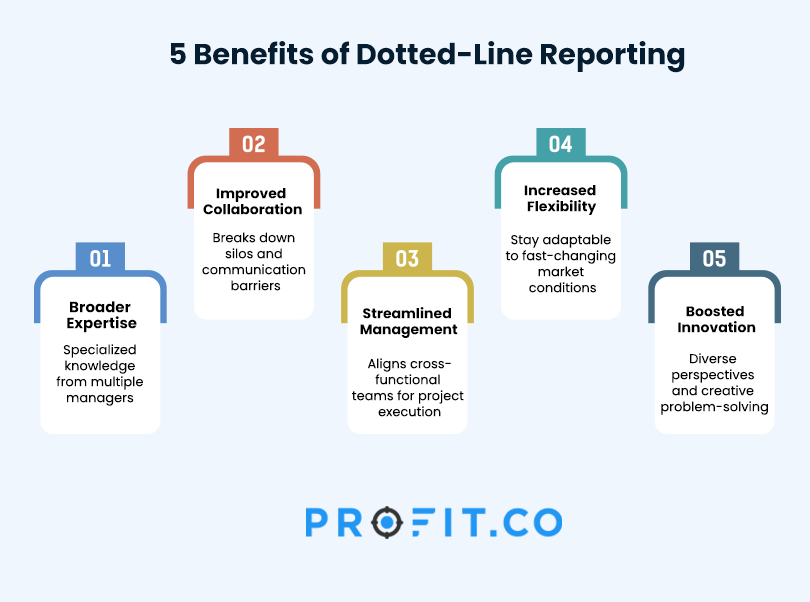The creative approach of dotted-line reporting ensures better collaboration and flexibility across departments, teams, or different functional areas.
Ever wondered why some teams seem to collaborate effortlessly, while others are bogged down by silos? The answer might just be dotted-line reporting.
Dotted line reporting can be an invaluable tool that enhances project management, flexibility and collaboration in any company or business. Dotted line relationships make it easier to understand and manage individual roles effectively, propelling efficiency and innovation.
As markets evolve, implementing dotted line reporting will help you create a more adaptive and dynamic business that leverages technology to remain agile. You can easily make changes based on market demands and maintain a thriving competitive edge.
So, what exactly is dotted line reporting and how can it benefit your organization? Let’s discuss the details of this reporting model to help you determine if it’s a smart business decision.
What Is Dotted Line Reporting?
Dotted-line reporting refers to a structure where employees continuously report to the supervisor and other team leaders or managers simultaneously. The primary or solid line manager is in charge of the team’s overall performance and individual team members report to him/her directly.
The secondary manager, indicated by a dotted line in management charts, offers support and guidance on particular tasks or projects while working in a different department.
The primary manager’s focus is on the overall responsibilities and long-term performance and development. The dotted-line manager prioritizes helping team members with particular tasks that contribute to the overall business goals. Although this manager has less authority than the solid line manager, they can still direct the team in some initiatives and allocate tasks.
This two-level reporting structure nurtures a collaborative work environment, where teams from various departments can share views, inputs, and ideas. In addition to encouraging diversity and creativity, dotted-line reporting ensures tactical alignment and teamwork that ultimately benefits your company.
It eliminates work silos and bureaucracies, encouraging your team to be part of the wider effort and contribute to the overall business goals.
The solid-line manager? They focus on long-term performance and development. The dotted-line manager? They bring in the expertise for specific projects, offering insights and direction when it matters most.
Manager solves problems, leader prevents them.
When to Use Dotted Line Reporting
Adopting dotted-line reporting can initially be challenging, but even wit h limited resources, the resulting progress is worth the effort. Whether this approach will be effective in your company depends on your particular needs and management structure.
It works perfectly in different scenarios, such as:
- Matrix Organizations
- Cross-functional Teams
- Multinational and Remote Enterprises
In a matrix organization, an individual in the marketing team may have a dotted-line relationship with the marketing manager and a solid-line relationship with the product manager.
Such a structure empowers your team to contribute to project-specific and departmental goals, enhancing collaboration and flexibility.
In cross-functional teams, different teams have dotted-line reporting relationships with project managers while reporting directly to their functional managers. This setup ensures teams and departments remain aligned and allows individuals to share diverse perspectives, skills, and expertise on a project.
In large or remote organizations, employees maintain a dotted reporting line with cross-regional or global heads and a solid line relationship with local managers. This setup ensures your team remains aligned with global standards and strategies and enables successful operations in different geographic locations.
Dotted Line vs. Solid Line Reporting: Key Differences
Dotted-line reporting requires an employee to maintain two reporting relationships:
- A solid line relationship with the immediate supervisor
- A dotted-line relationship with another leader or manager
The primary reporting structure is the solid line, while the secondary structure is the dotted line relationship with another leader outside direct supervision. Although the dotted line manager and solid line manager work together, they play different roles in leadership.
The solid line manager has more authority and is responsible for aspects such as bonuses and salary reviews and performance evaluations.
A dotted line manager, on the other hand, relates differently with the team and handles tasks like task allocation in interdepartmental projects, quality review, and providing feedback.
Ready to Boost Efficiency?
Benefits of Dotted Line Reporting
Dotted-line reporting equips your company with the agility to swiftly adapt to dynamic business and market requirements. You can easily create an effective and efficient cross-functional team that can manage upcoming issues and optimize business opportunities.
Other outstanding benefits of a dotted-line reporting relationship include:
- Enhanced Expertise and Efficiency
- Better Collaboration
- Enhanced Project Management
Dotted-line reporting makes it possible to use various skills within your team more effectively. One person doesn’t have to know everything. You can delegate tasks to team members with a better understanding.
Maintaining secondary reporting relationships allows team members to contribute their unique expertise and skills to initiatives and projects outside their immediate roles.
For instance, a marketing expert can have a dotted-line relationship with the project developers to share key insights on popular trends and customer preferences. These insights set the new product up for success by improving its effectiveness and overall quality.
Dotted-line reporting reduces and eliminates communication silos within a company. Employees with secondary reporting relationships with leaders beyond their immediate teams collaborate and communicate better, encouraging them to share ideas and knowledge.
For example, a user experience designer with a dotted-line reporting relationship to a software engineer can help design a more appealing interface and ensure the technical aspects align with user preferences and needs.
Such a collaborative environment makes way for a positive team culture that thrives on innovation and transparency. Encourages teams towards higher-quality outputs and cohesiveness leading to better job satisfaction.
Dotted-line reporting is an excellent method of team management to streamline and coordinate project management. It works well, especially in cross-functional initiatives requiring input from various teams or departments.
Aligning dotted-line reporting relationships with critical project stakeholders enables coordination and accountability. It becomes easier to overcome possible bottlenecks, allocate resources efficiently, and meet project milestones.

Challenges of Dotted Line Reporting
Once you have decided to implement dotted line reporting in your company, it’s best to understand all possible challenges you may come across.
Some examples are:
- Accountability and Performance Evaluation
- Micromanagement and Communication Breakdown
- Confusion and Mismatched Priorities
Proper accountability and performance evaluation is a bit of a challenge with dotted-line reporting. Team members may receive conflicting performance reviews and feedback from the dotted-line and solid-line managers. This confusion can lead to lower performance, which becomes more challenging to address with multiple managers sharing inputs.
Communication breakdowns in dotted-line reporting often occur when there’s no clear definition of responsibilities, roles, and expectations.
If both dotted-line and solid-line managers issue detailed instructions or closely monitor activities, team members may feel micromanaged and overwhelmed.
Besides lowering productivity, such an environment can trigger disengagement and hinder creativity.
Juggling multiple reporting lines can leave your team confused about what to prioritize. Different managers give feedback and instructions based on individual perspectives or agendas.
Team members become uncertain about which direction to take or which tasks to focus on. This confusion can be frustrating, resulting in inefficiency, low performance, and poor-quality outputs.
Best Practices for Managing Dotted Line Relationships
Dotted-line reporting has the potential to elevate your business to new levels, as long as you implement it well. Here are some best practices that will increase your chances of succeeding:
- Schedule Regular Check-ins
- Clear Communication
- Implement Performance Management Strategies
Having regular team check-ins is an effective way to keep everyone working towards the same goals. Cultivate a culture of clear and timely communication and ensure everyone understands their responsibilities and roles.
Dotted-line reporting requires clear two-way communication to be effective. All team members should know the right person to report what and when.
Leaders should communicate clearly about the daily tasks to prioritize and outline which team member is responsible for certain tasks and when to deliver results.
Encourage regular feedback and create a positive environment where everyone feels comfortable being honest about what is productive and what needs adjustment.
Dotted-line reporting can have some complex aspects so you need performance management strategies that can accommodate these areas.
For instance, performance reviews involve both dotted-line and solid-line managers. You need a platform that allows joint reviews to ensure an employee’s performance report is fair and consistent.
Outline clear OKRs and performance metrics that align with the overall business goals and encourage support and constructive feedback from your leaders.
FAQs
1. How does a dotted line differ from a solid line in a dotted line org chart?
A dotted line shows the relationship between a secondary manager and employees while a solid line indicates the relationship between a direct manager and employees.
2. Is dotted-line reporting suitable for remote work environments?
Yes, you can implement dotted-line reporting in remote and hybrid work environments. Innovative tools and platforms make it easy to coordinate and collaborate with managers and team members. These invaluable tools facilitate regular check-ins, virtual meetings, and real-time communication channels.
In addition to organizational alignment, you can ensure accountability regardless of the physical distance.
3. How can I handle conflicts in dotted-line reporting?
The best way to address conflict in this reporting structure is to offer continuous support and training to your team. Have a strategic system to monitor and share feedback to keep open communication lines. This way, you can address any issues swiftly before they affect performance.
Conclusion
Adopting dotted line reporting is an excellent and highly effective way to keep your company agile and flexible in the dynamic business environment. It allows you to optimize your team’s talent, skills, and expertise while enhancing collaboration.
With an innovative and easy-to-use management platform, following best practices like clear communication, regular check-ins, and performance management becomes easy. You can create an empowered team that will keep your business thriving among the competition.

